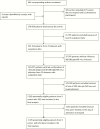Impact of Outpatient Neuraminidase Inhibitor Treatment in Patients Infected With Influenza A(H1N1)pdm09 at High Risk of Hospitalization: An Individual Participant Data Metaanalysis
- PMID: 28199524
- PMCID: PMC5411393
- DOI: 10.1093/cid/cix127
Impact of Outpatient Neuraminidase Inhibitor Treatment in Patients Infected With Influenza A(H1N1)pdm09 at High Risk of Hospitalization: An Individual Participant Data Metaanalysis
Abstract
Background: While evidence exists to support the effectiveness of neuraminidase inhibitors (NAIs) in reducing mortality when given to hospitalized patients with A(H1N1)pdm09 virus infection, the impact of outpatient treatment on hospitalization has not been clearly established. We investigated the impact of outpatient NAI treatment on subsequent hospitalization in patients with A(H1N1)pdm09 virus infection.
Methods: We assembled general community and outpatient data from 9 clinical centers in different countries collected between January 2009 and December 2010. We standardized data from each study center to create a pooled dataset and then used mixed-effects logistic regression modeling to determine the effect of NAI treatment on hospitalization. We adjusted for NAI treatment propensity and preadmission antibiotic use, including "study center" as a random intercept to account for differences in baseline hospitalization rate between centers.
Results: We included 3376 patients with influenza A(H1N1)pdm09, of whom 3085 (91.4%) had laboratory-confirmed infection. Eight hundred seventy-three patients (25.8%) received outpatient or community-based NAI treatment, 928 of 2395 (38.8%) with available data had dyspnea or respiratory distress, and hospitalizations occurred in 1705 (50.5%). After adjustment for preadmission antibiotics and NAI treatment propensity, preadmission NAI treatment was associated with decreased odds of hospital admission compared to no NAI treatment (adjusted odds ratio, 0.24; 95% confidence interval, 0.20-0.30).
Conclusions: In a population with confirmed or suspected A(H1N1)pdm09 and at high risk of hospitalization, outpatient or community-based NAI treatment significantly reduced the likelihood of requiring hospital admission. These data suggest that community patients with severe influenza should receive NAI treatment.
Keywords: hospitalization; individual participant data metaanalyses; influenza; neuraminidase inhibitors; pandemic..
© The Author 2017. Published by Oxford University Press for the Infectious Diseases Society of America.
Figures
Comment in
-
Findings of an Observational Study of Neuraminidase Inhibitors Highly Sensitive to Decision to Exclude 1652 Treated Patients.Clin Infect Dis. 2017 Sep 15;65(6):1050. doi: 10.1093/cid/cix425. Clin Infect Dis. 2017. PMID: 28505232 No abstract available.
-
Reply to Jones et al.Clin Infect Dis. 2017 Sep 15;65(6):1051. doi: 10.1093/cid/cix427. Clin Infect Dis. 2017. PMID: 28505297 No abstract available.
References
-
- Nguyen-Van-Tam JS, Openshaw PJ, Nicholson KG. Antivirals for influenza: where now for clinical practice and pandemic preparedness? Lancet 2014; 384:386–7. - PubMed
-
- Kelly H, Cowling BJ. Evidence and policy for influenza control. Euro Surveill 2014; 19:2–4. - PubMed
-
- Muthuri SG, Myles PR, Venkatesan S, Leonardi-Bee J, Nguyen-Van-Tam JS. Impact of neuraminidase inhibitor treatment on outcomes of public health importance during the 2009–2010 influenza A(H1N1) pandemic: a systematic review and meta-analysis in hospitalized patients. J Infect Dis 2013; 207: 553–63. - PMC - PubMed
-
- Muthuri SG, Venkatesan S, Myles PR, et al. ; PRIDE Consortium Investigators Effectiveness of neuraminidase inhibitors in reducing mortality in patients admitted to hospital with influenza A H1N1pdm09 virus infection: a meta-analysis of individual participant data. Lancet Respir Med 2014; 2:395–404. - PMC - PubMed
Publication types
MeSH terms
Substances
Grants and funding
LinkOut - more resources
Full Text Sources
Other Literature Sources
Medical


